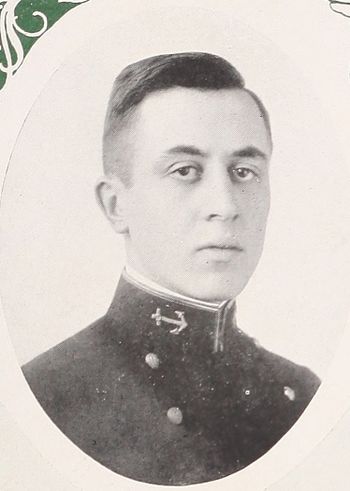FREDERICK S. CHAPPELLE, 1LT, USMC
Frederick Chappelle '20
Lucky Bag
From the 1920 Lucky Bag:
Frederick Strayee Chappelle
Waterloo, New York
"Capillo" "Frenchie" "Chapie" "Sqaure" "Larry"
HERE'S a man who takes things as they come. If he is impelled by any motives to turn the world upside down he keeps them in himself, and doesn't go around hunting for something extraordinary to do. On the other hand, when there's work to be done, he does it, without hesitation.
As a fusser he's a dove of peace, but there's a "method in his madness." We don't know for sure, but we have a hunch, from certain occasional visits to Caldwell's, that he made his success in tea lighting before entering the Naval Academy. Some girl's lucky!
Before we forget it, "Fred" told us to mention his marvelous athletic ability. He's a great athlete, but we can't say much about it, because we've forgotten whether he plays third base or left tackle.
He's about as reg as a Plebe for Saturday noon inspection, and is the immortal author of "I'd rather be reg than five-striper." If you just don't look inside his Locker, his room looks like the parlor in a movie palace, but if he'd ever fail to get out of the room Sunday morning before 9:30—oh, boy! the inside of that locker would look like he'd shuffled his clothes and forgot to deal 'em.
All seriousness aside, "Fred" is a fine fellow. He must be to make friends so easily. And he's always ready with some curt humor that makes everybody around him goodnatured.
"Mr. Gish, you're on the pap for walking on the grass, two particulars both feet."
Honors: Buzzard.
The Class of 1920 was graduated in June 1919 due to World War I. The entirety of 2nd class (junior) year was removed from the curriculum.

Frederick Strayee Chappelle
Waterloo, New York
"Capillo" "Frenchie" "Chapie" "Sqaure" "Larry"
HERE'S a man who takes things as they come. If he is impelled by any motives to turn the world upside down he keeps them in himself, and doesn't go around hunting for something extraordinary to do. On the other hand, when there's work to be done, he does it, without hesitation.
As a fusser he's a dove of peace, but there's a "method in his madness." We don't know for sure, but we have a hunch, from certain occasional visits to Caldwell's, that he made his success in tea lighting before entering the Naval Academy. Some girl's lucky!
Before we forget it, "Fred" told us to mention his marvelous athletic ability. He's a great athlete, but we can't say much about it, because we've forgotten whether he plays third base or left tackle.
He's about as reg as a Plebe for Saturday noon inspection, and is the immortal author of "I'd rather be reg than five-striper." If you just don't look inside his Locker, his room looks like the parlor in a movie palace, but if he'd ever fail to get out of the room Sunday morning before 9:30—oh, boy! the inside of that locker would look like he'd shuffled his clothes and forgot to deal 'em.
All seriousness aside, "Fred" is a fine fellow. He must be to make friends so easily. And he's always ready with some curt humor that makes everybody around him goodnatured.
"Mr. Gish, you're on the pap for walking on the grass, two particulars both feet."
Honors: Buzzard.
The Class of 1920 was graduated in June 1919 due to World War I. The entirety of 2nd class (junior) year was removed from the curriculum.
Loss
Frederick was lost on October 24, 1933 when he died of injuries sustained in the collision of USS Chicago (CA 29) with a British merchant steamer off the coast of Point Sur, California. He was cut from the damaged ship, "evacuated to a hospital when the ship put in to San Francisco," but died six hours later.
Other Information
From researcher Kathy Franz:
Frederick and his brother George belonged to Boy Scout Troop 1 of St. Paul’s Church. In March 1915 they organized a baseball team, and Frederick was elected captain.
Frederick graduated from Waterloo high school in 1916.
His father George was a master mechanic in a distillery.
From the Clifton Springs Press, New York, circa February, 1928:
Two former Western New York people, Lieutenant and Mrs. Frederick Chappelle, write from the Island of Haiti that they helped to entertain Col. Lindbergh when the “ambassador of peace” visited the island. Mrs. Chappelle, in a letter to her parents, Mr. and Mrs. John Boyce of Waterloo, said: “We had a splendid opportunity to see Lindbergh. We had lunch with him the day he landed and attended a reception for him the next night.” [Photo below.]
From the Waterloo Observer, October 26, 1933:
Frederick Strayer Chappelle was born in Waterloo thirty-six years ago. At the age of twelve his mother died. In school he showed unusual brilliance and also excelled in all forms of athletics. His prowess in sports and his upstanding character together with his pleasing personality made him the idol of many of his companions and a leader in all activities.
He stood high in his scholastic work, acquiring many honorary rewards, and had enough counts to graduate from High School a whole term before the usual four years. At the same time he was an outstanding athlete, being a star in basketball, football and baseball. He played third base for the local professional team while still in High School and sometimes relieved the pitcher. One knee, injured in athletics, bothered some by slipping out of joint. One time in a game here, he had reached third base after a sound hit and just as he rounded that bag the knee slipped out of joint. He went down, but not out. With his hands he crawled as rapidly as possible along the third base line and reached the home plate in time to score a run for the home team. In basketball he was an exceptionally good shot, having an uncanny ability to flip the ball into the basket from any angle and almost any distance. In football he was a fast and elusive runner and an asset to the backfield strength of his team. He was equally as expert in other minor sports such as swimming, running, and boating.
When he was but fourteen years of age he wrote a letter to Congressman Payne, a Democratic Representative from this District at that time, telling this man of his desire to make something of himself and fearing that his parents would not be able to provide him a college education. He wrote of his desire to enter either West Point or Annapolis. Congressman Payne answered him, telling him to continue his school work and that when the time came he would do all he could to help him into one of those schools. Before Fred finished, this man died, but the letter from the fourteen year old school boy was handed on to his successor, Norman J. Gould.
In January of the year he was supposed to have graduated from the high school here, having all the credits needed for graduation, he left the school here and went to the Wilmer Chew Preparatory School. He prepared there for the entrance examinations to the Naval Academy and successfully passed them in June. The Nation was at war then and he was immediately sent out on a cruise. Later he was allowed to return at once through the efforts of Congressman Gould. He continued his work there and graduated with one of the two classes that were put through in three years instead of the usual four.
Frederick is buried in New York.
Photographs
The "Register of Commissioned and Warrant Officers of the United States Navy and Marine Corps" was published annually from 1815 through at least the 1970s; it provided rank, command or station, and occasionally billet until the beginning of World War II when command/station was no longer included. Scanned copies were reviewed and data entered from the mid-1840s through 1922, when more-frequent Navy Directories were available.
The Navy Directory was a publication that provided information on the command, billet, and rank of every active and retired naval officer. Single editions have been found online from January 1915 and March 1918, and then from three to six editions per year from 1923 through 1940; the final edition is from April 1941.
The entries in both series of documents are sometimes cryptic and confusing. They are often inconsistent, even within an edition, with the name of commands; this is especially true for aviation squadrons in the 1920s and early 1930s.
Alumni listed at the same command may or may not have had significant interactions; they could have shared a stateroom or workspace, stood many hours of watch together… or, especially at the larger commands, they might not have known each other at all. The information provides the opportunity to draw connections that are otherwise invisible, though, and gives a fuller view of the professional experiences of these alumni in Memorial Hall.
January 1920
January 1921
May 1923
July 1923
September 1923
November 1923
January 1924
March 1924
May 1924
July 1924
September 1924
November 1924
January 1925
March 1925
May 1925
July 1925
October 1925
January 1926
October 1926
January 1927
April 1927
October 1927
January 1928
April 1928
July 1928
October 1928
January 1929
April 1929
July 1929
October 1929
January 1930
April 1930
October 1930
January 1931
April 1931
July 1931
October 1931
January 1932
April 1932
October 1932
January 1933
April 1933
July 1933
LTjg William Pennewill '29 (Scouting Plane Squadron (VS) 10S)
ENS Augustus Alston, Jr. '31 (Cruiser Division 5)
October 1933
LTjg William Pennewill '29 (Scouting Plane Squadron (VS) 10S)
ENS Augustus Alston, Jr. '31 (Cruiser Division 5)
Related Articles
Harold MacFarlane '29 was also lost in this incident.

The "category" links below lead to lists of related Honorees; use them to explore further the service and sacrifice of alumni in Memorial Hall.
